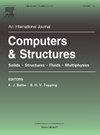Introducing large-scale multiphysics topology optimization for electric aircraft battery pack design
IF 4.4
2区 工程技术
Q1 COMPUTER SCIENCE, INTERDISCIPLINARY APPLICATIONS
引用次数: 0
Abstract
Electric Vertical Take-Off and Landing (eVTOL) vehicles hold great promise for mitigating traffic congestion and the performance of eVTOL battery packs plays a crucial role in advancing this mode of transportation. This paper introduces a methodology for optimizing eVTOL battery packs, employing level-set topology optimization while accounting for multiphysics loads to achieve a lightweight structure that is thermally and structurally efficient. A beam model at the system level simulates the boom hosting the battery pack, determining the mechanical load borne by the battery pack and an electrochemical model predicts the batteries’ maximum heat generation given a mission profile. These contributions serve as inputs for the thermo-mechanical battery pack model. The workflow is exemplified with a battery module comprising seven battery cells with the objective of minimizing thermal and structural compliances while exploring the trade-off between these two factors. Subsequently, the model is expanded to optimize the entire boom structure. The model, with over 50 million degrees of freedom, is solved using distributed memory parallelism to minimize structural compliance while adhering to volume, stress, and temperature constraints. This study demonstrates the application of large-scale multiphysics optimization in designing battery packs, facilitating the development of lightweight electric aircraft.
介绍了面向电动飞机电池组设计的大规模多物理场拓扑优化
电动垂直起降(eVTOL)车辆在缓解交通拥堵方面前景广阔,eVTOL电池组的性能在推进这种运输方式方面发挥着至关重要的作用。本文介绍了一种优化eVTOL电池组的方法,该方法采用水平集拓扑优化,同时考虑多物理场负载,以实现热效率和结构效率高的轻量化结构。系统级的光束模型模拟了承载电池组的臂架,确定了电池组所承受的机械负荷,电化学模型预测了给定任务剖面下电池的最大发热量。这些贡献作为热机械电池组模型的输入。该工作流程以一个由七个电池单元组成的电池模块为例,其目标是最大限度地减少热和结构遵从性,同时探索这两个因素之间的权衡。随后,对模型进行扩展,以优化整个臂架结构。该模型具有超过5000万个自由度,使用分布式内存并行性来解决问题,以最大限度地减少结构遵从性,同时遵守体积,应力和温度限制。该研究展示了大规模多物理场优化在电池组设计中的应用,促进了轻型电动飞机的发展。
本文章由计算机程序翻译,如有差异,请以英文原文为准。
求助全文
约1分钟内获得全文
求助全文
来源期刊

Computers & Structures
工程技术-工程:土木
CiteScore
8.80
自引率
6.40%
发文量
122
审稿时长
33 days
期刊介绍:
Computers & Structures publishes advances in the development and use of computational methods for the solution of problems in engineering and the sciences. The range of appropriate contributions is wide, and includes papers on establishing appropriate mathematical models and their numerical solution in all areas of mechanics. The journal also includes articles that present a substantial review of a field in the topics of the journal.
 求助内容:
求助内容: 应助结果提醒方式:
应助结果提醒方式:


